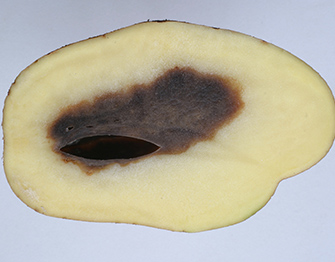Please click here to access the main AHDB website and other sectors.
- Home
- Knowledge library
- Potato store atmosphere: CO2 and processing quality
Potato store atmosphere: CO2 and processing quality
In store, potato tubers continue to respire. The process consumes oxygen and releases carbon dioxide (CO2 ) and some heat energy which can impact storage systems and crop quality.
Oxygen
A lack of oxygen in a potato store can lead to blackheart, where the central core of the potato is starved of oxygen and the result is an odourless, blackened area in the central pith tissue. Susceptibility to blackheart is a complex issue with multiple causes related to tuber stress, so it cannot be assumed to be linked to oxygen levels in all cases.
Carbon dioxide
Carbon dioxide (CO2 ) levels in potato stores are often in the region of 0.3–0.5% (3,000–5,000 parts per million), which is about 10 times the 0.04% level normally found in air. Modern, highly sealed stores are more likely to have higher levels of carbon dioxide if the air within the store is not freshened daily. Carbon dioxide can accumulate to levels as high as 3% at times of high crop respiration.
Crop respiration rates are higher immediately after harvest, following the thermal application of sprout suppressants and also when using ethylene in store.
Monitoring and managing CO2 levels
Many storage control systems are now available with CO2 sensors, allowing measurement and control of the store atmosphere automatically. Portable CO2 sensors can also be used to monitor levels at times of high crop respiration. The main priority for the potato crop is to control excessive build-up, which may induce stress-related responses. Recent control systems are using CO2 levels as an indicator of crop stability and instigate ‘flushing’ or ‘purging’ regularly to maintain low levels of CO2 at all times.
Impact of CO2 build-up on the fry quality of processing varieties
For spearmint and orange oil treatments, it is recommended that stores are closed for at least 48 hours after application to ensure optimal absorption of the active in tubers. AHDB Potatoes funded trials to assess whether the resulting CO2 build-up from extended store closure affects fry quality.
Two different store closure regimes were compared. One with the store managed to not exceed 3,000 ppm carbon dioxide and sealed for 48 hours after mint oil application and the other managed to 10,000 ppm and sealed for 72 hours after application. After 35 weeks in stores, no significant differences in fry colour were observed between the two store closure regimes, indicating that carbon dioxide is not important in determining fry colour.
But it is crucial to consider that for this to happen, ethylene must remain absent. Ethylene sources could be unburnt fuel from petrol-driven foggers, contamination from an adjacent store using ethylene as a sprout suppressant or simply the exhaust of a gas or diesel-powered forklift truck being used in the store.
Previous research has shown that the interaction between CO2 and ethylene has a detrimental impact on fry colour. In this work, with very low levels of ethylene (0.25 ppm) present, carbon dioxide darkened fry colour so the higher the carbon dioxide levels, the darker the fry colour.

Tuber showing blackheart symptoms
Elevated CO2 levels are a risk to human health. Refer to the HSE website for workplace exposure limits for CO2

